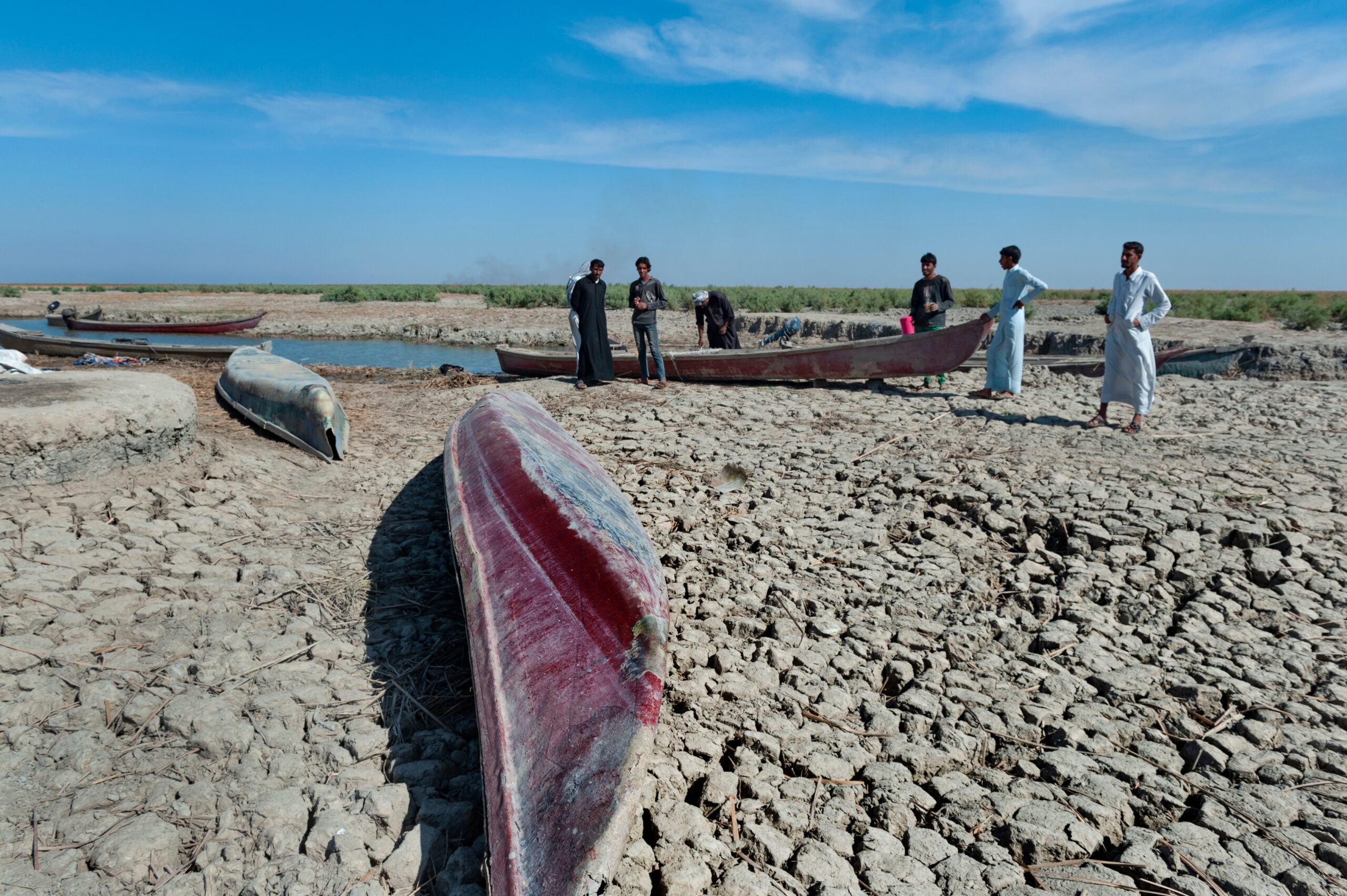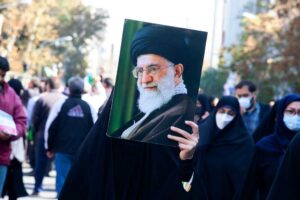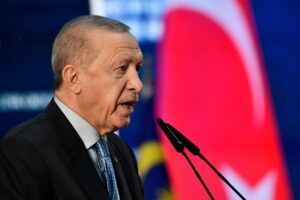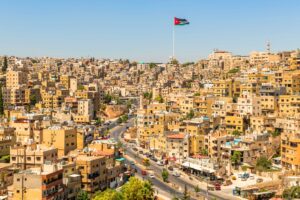The Dubai floods must catalyse foreign policymakers to prioritise climate-change preparedness throughout the Middle East, to avoid exacerbated conflicts and insecurity.
Photographs of Dubai tend to focus on its towering skyscrapers or luxurious man-made beaches. The contrast with the images of the swamped city that appeared in global media outlets in April are stark. Record rainfall in the region flooded roads, trapped residents, and caused at least four fatalities in the UAE[i] and twenty in Oman.[ii] The scenes underscore a broader reality: the Middle East is increasingly experiencing extreme climate events with devastating consequences. In 2018 alone, a water shortage caused by drought and extreme heat hospitalised more than 10,000 people in Iraq with respiratory complications.[iii] Experts warn that by 2035, the country could face dust storms 272 days a year. As the world refocuses its attention on the Middle East, the already severe problem of regional climate insecurity and the need to prepare for climate change should be made a conspicuous priority.
Climate change is projected to act as a critical threat multiplier in the region[iv], propagating cascading social and political unrest, and both deepening conflict and shaping responses to it. Many examples of this already exist. Disputes over water rights between Iran and Afghanistan, Iraq, and Turkey have led to deadly skirmishes.[v] Drought in the late 2000s is generally understood to have precipitated social and economic shocks, culminating in the Syrian Civil War.[vi] The impact of this conflict has been significant not only for Syria, but also for neighbours, with Jordan currently hosting over half a million officially registered Syrian refugees (and potentially double that number in reality). This has placed further pressure on Jordan’s water resources, invalidating existing, carefully developed, forecasts and adaptive measures in its water sector. It has also increased the scale of new supply and other interventions necessary to build future water security.[vii] The increased scale of challenge facing Jordan has arguably reduced its option space for future water supplies, and further necessitated cooperation with Israel over meeting part of its future needs. This itself could be considered to have increased the stakes and fine political, diplomatic and socio-political balances on Jordan’s response to the Israel-Hamas conflict post October 7 2023.
A growing number of regional and global policymakers recognize climate change as a sufficiently urgent and large-scale threat to place it in the realm of realpolitik. As researchers observe, perhaps even more acutely amid the fragility of war, “countries recognize the heightened climate dangers confronting them,” viewing an “ability to promote regional cooperation on climate issues” as central to national resilience.[viii] The United States and the EU are also conscious of the multiplier threats of climate change to the most vulnerable areas of the world,[ix] [x] and the need for action. This is in part motivated by self-interest in internal and global stability, and concerns about migration and the threat of climate refugees.
Despite the emerging threats and policy discourse around the need and justification for action, foreign policy still continues largely to overlook climate change as a core security or diplomatic issue. In consequence, traditional Grand Strategy is increasingly misaligned to the threats emerging in an era of extreme climate change. Without greater attentiveness from the foreign policy community, climate change could further exacerbate regional conflicts, and unleash unprecedented security, humanitarian, trade and investment challenges impacting countries around the world.
Persistent challenges to address include interconnected issues of water, energy, and food security, where climate impact in one part of the nexus can have significant magnified consequences elsewhere.
The international community has a role to play in bolstering regional cooperation and supporting local climate adaptation. Persistent challenges to address include interconnected issues of water, energy, and food security, where climate impact in one part of the nexus can have significant magnified consequences elsewhere. Global food supply is also at risk under conditions of climate change, in light of increased water demands, degradation of land and soil resources, and heat extremes reducing both yield in key producing areas and the availability and stability of agricultural labour. There is a critical need for cross-border and regional cooperation on water and energy resources, as well as for cooperative interventions to mitigate impacts, especially by upstream countries to their downstream neighbours. This includes data sharing for resource management operations, resource availability, resource extremes, and planning. For example, Egyptian agriculture is likely to be adversely impacted by climate change, and faces an increasingly tight water economy with population growth and a fixed Nile water allocation of 55bcm. Cooperation with upstream states, especially Ethiopia, in their operation of storages could potentially mitigate the impact of variations in Egyptian inflows, improving drought management planning.[xi]
As COP28’s Loss and Damage Fund kicks in[xii], for which many countries in the region will be eligible, the international community must emphasise not only additional funding needs[xiii], but also effectiveness and the quality of financing. At least $150 million has poured into Iraq from USAid alone to tackle water resource issues in recent years. This is needed: communities are already being forced to migrate and experiencing a loss of their livelihoods. But in Silent Crisis: Information, decisionmaking and communities on the frontlines of climate change[xiv], researchers found that communities in Iraq felt severely abandoned by the state and the international policy community. If local communities are to be supported in adapting to new realities, and at the appropriate speed, their perspectives must better and more consistently enter national decision-making processes and the global conversations that play an influential role in shaping humanitarian aid and economic development. Cookie-cutter behavioural interventions designed from afar must give way to more urgent and localised responses.
Longer-term solutions are also needed, requiring regional collaboration on infrastructure-scale climate projects. The I2U2 “minilateral” comprising the UAE, Israel, India, and the US has made an initial commitment to collaborate on climate R&D, including agreements on water security as well as research and food technology.[xv] Technology collaboration rooted in regional knowledge could help to avoid the risk of “techno universalism”—importing technologies designed with scant understanding of the needs and context of specific countries and regions—which has characterised much of the technology transfers of the late 20th and early 21st centuries. With the actual and looming threat of climate-related impacts, costly failures experienced in the past cannot be afforded in the future. Regional actors also recognise the urgent need to transition to a post-oil economy, with many climate activists doubting that large-scale environmental technologies will make a significant impact while oil and gas production persists.
Recent floods in Gulf countries further underscore the critical nature of regional city-level climate preparedness. 66% of people in the Middle East live in urban environments[xvi], outpacing the global average of urbanisation by at least 10%. Even where countries have National Adaptation Plans (NAPs) (with great variation in stages of development across the region[xvii]), cities and their infrastructure need specific support to tackle climate-related shocks, from drought to flooding, and stresses including food and water insecurity that extreme climate events can worsen. Middle Eastern cities are underrepresented in peer-to-peer global urban resilience networks. They could learn from practices elsewhere. Cape Town developed its Resilience Strategy[xviii], for example, in the aftermath of its worst drought in recorded history. The strategy stands out for emphasising the technological, behavioural, and policy interventions required for survival and flourishing amid rapid climate change.
Timely support for countries and communities worst impacted by climate change may become a matter of global justice,[xix] but not only that. The interconnected consequences of climate crisis, including migration as well as food and energy insecurity mean the pace of change and depths of potential impact in the Middle East could have far-reaching implications for security and stability worldwide. Without concerted action, the future of the Middle East may hold increased conflict, migration, and resource insecurity that penetrate across borders in the region, and spill beyond the region’s boundaries. Climate change must be a foreign policy priority today.
[i] Reuters (2024). “UAE reels for a third day after record-breaking storm”, 18 April 2024, retrieved from: https://www.reuters.com/world/middle-east/uae-reels-third-day-after-record-breaking-storm-2024-04-18/.
[ii] World Weather Attribution (2024). “Heavy precipitation hitting vulnerable communities in the UAE and Oman becoming an increasing threat as the climate warms”, 25 April 2024, retrieved from: https://www.worldweatherattribution.org/heavy-precipitation-hitting-vulnerable-communities-in-the-uae-and-oman-becoming-an-increasing-threat-as-the-climate-warms/#:~:text=Extreme%20rainfall,-Asia&text=From%20April%2014%20to15%202024,and%20four%20in%20the%20UAE.
[iii] Gross, J.E., Carlos, W.G., Dela Cruz, C.S., Harber, P. and Jamil, S. (2018). “Sand and Dust Storms: Acute Exposure and Threats to Respiratory Health”, American Journal of Respiratory and Critical Care Medicine, 198 (7), 13-14.
[iv] Foreign Policy (2020). “Climate and Security”, 22 April 2020, retrieved from: https://foreignpolicy.com/2020/04/22/climate-change-security-poverty-food-water-fragile-states-peacegames/.
[v] Dagres, H. (2023). “Iran and Afghanistan are feuding over the Helmand River. The water wars have no end in sight”, Atlantic Council, 7 July 2023, retrieved from: https://www.atlanticcouncil.org/blogs/iransource/iran-afghanistan-taliban-water-helmand/.
[vi] Kelley, C.P. et al. (2015). “Climate Change in the Fertile Crescent and implications of the recent Syrian drought”, Earth, Atmospheric and Planetary Sciences, 112 (11), 3241-3246, retrieved from: https://www.pnas.org/doi/abs/10.1073/pnas.1421533112.
[vii] Westheimer, N. et al. (2019). “Hotel Middle East: social shocks and adaptation in Jordan’s domestic water sector”, Water International, 44 (4), 444-462, retrieved from: https://www.tandfonline.com/doi/abs/10.1080/02508060.2019.1622277
[viii] Cohen, G. and Shani, G. (2023). “Uniting Fronts: The War and the Climate Crisis”, INSS, 22 November 2023, retrieved from: https://www.inss.org.il/publication/war-climate-change/.
[ix] U.S. Department of State (2023). “The Climate Crisis: Working Together for Future Generations”, retrieved from: https://www.state.gov/policy-issues/climate-crisis/#:~:text=Failing%20to%20keep%20the%20goal,pose%20grave%20national%20security%20threats
[x] Lazarou, E. and Tothova, L. (2022). “ Climate change considerations for EU security and defence policy”, EPRS, retrieved from: https://www.europarl.europa.eu/RegData/etudes/BRIE/2022/729467/EPRS_BRI(2022)729467_EN.pdf
[xi] Wheeler, K.G. et al. (2016).” Cooperative filling approaches for the Grand Ethiopian Renaissance Dam”, Water International 41 (4), 611-634, retrieved from: https://www.tandfonline.com/doi/epdf/10.1080/02508060.2016.1177698?src=getftr
[xii] World Economic Forum (2023). “COP28 agrees to establish loss and damage fund for vulnerable countries”, 1 December 2023, retrieved from: https://www.weforum.org/agenda/2023/12/cop28-loss-and-damage-fund-climate-change/.
[xiii] Lakhani, N. (2023). “$700m pledged to loss and damage fund at Cop28 covers less than 0.2% needed”, The Guardian, 6 December 2023, retrieved from: https://www.theguardian.com/environment/2023/dec/06/700m-pledged-to-loss-and-damage-fund-cop28-covers-less-than-02-percent-needed.
[xiv] Diepeveen, S., Filer, T., Czibor, E., Gandhuri, T. and Molana-Allen, L. (2023). “Silent Crisis: New report reveals urgent information needs on frontlines of climate change”, 4 December 2023, retrieved from: https://stateup.co/silent-crisis-new-report-reveals-urgent-information-needs-on-frontlines-of-climate-crisis/.
[xv] https://www.orfonline.org/research/i2u2-brings-hi-tech-food-clean-energy-projects.
[xvi] Ritchie, H. Samborska, V. and Roser, M. (2021). “Urbanization”, Our World in Data, retrieved from: https://ourworldindata.org/urbanization.
[xvii] Osman, S. (2024). “Assessing Climate Adaptation Plans in the Middle East and North Africa”, Carnegie Endowment for International Peace, 15 April 2024, retrieved from: https://carnegieendowment.org/research/2024/04/assessing-climate-adaptation-plans-in-the-middle-east-and-north-africa?lang=en.
[xviii] City of Cape Town (2019). “Cape Town Resilience Strategy”, 22 August 2019, retrieved from: https://resource.capetown.gov.za/documentcentre/Documents/City%20strategies%2C%20plans%20and%20frameworks/Resilience_Strategy.pdf.
[xix] Vox Talks Economics (2023). “How should development respond to the challenges of the 21st century?”, retrieved from: https://cepr.org/system/files/2023-07/PSE_Esther_Duflo.pdf.

















